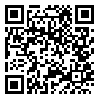Volume 19, Issue 1 (6-2021)
sjsph 2021, 19(1): 85-98 |
Back to browse issues page
Download citation:
BibTeX | RIS | EndNote | Medlars | ProCite | Reference Manager | RefWorks
Send citation to:



BibTeX | RIS | EndNote | Medlars | ProCite | Reference Manager | RefWorks
Send citation to:
Eynypour J, Bayat M, Pashang S. Prediction of University Students' Internet Addiction Based on Brain-Behavioral Systems. sjsph 2021; 19 (1) :85-98
URL: http://sjsph.tums.ac.ir/article-1-5995-en.html
URL: http://sjsph.tums.ac.ir/article-1-5995-en.html
1- , Joooo.einipour@gmail.com
Abstract: (2467 Views)
Background and Aim: Internet addiction means excessive and unnecessary use of the Internet. The aim of this study was to investigate the role of brain-behavioral systems in Internet addiction among university students.
Materials and Methods: This was a descriptive and correlational research. The statistical population was all the students of Islamic Azad University, Karaj Branch in the academic year 1397-98. A sample of 162 students were selected, based on the Tabachnick & Fidell formula, using the multi-phase cluster sampling technic. The tools used to collect data were the harmful Internet use and the brain and behavioral system questionnaires.
Results: Based on the multivariate regression analysis, 66.7% of Internet addiction among the students could be explained by brain-behavioral systems. Active avoidance and approach, as components of the behavioral activation system, could predict Internet addiction negatively, while passive avoidance and extinction, as components of the behavioral inhibition system, and fight and flight from the components of the fight/flight system, could predict Internet addiction positively.
Conclusion: Purposeful communication and information search (pleasant unconditional stimuli), tedium and constant logic dominating the internet environment (unpleasant unconditional stimuli) have their own conditional cues on the Internet that indicate the degree of susceptibility of brain-behavioral systems to internet addiction.
Materials and Methods: This was a descriptive and correlational research. The statistical population was all the students of Islamic Azad University, Karaj Branch in the academic year 1397-98. A sample of 162 students were selected, based on the Tabachnick & Fidell formula, using the multi-phase cluster sampling technic. The tools used to collect data were the harmful Internet use and the brain and behavioral system questionnaires.
Results: Based on the multivariate regression analysis, 66.7% of Internet addiction among the students could be explained by brain-behavioral systems. Active avoidance and approach, as components of the behavioral activation system, could predict Internet addiction negatively, while passive avoidance and extinction, as components of the behavioral inhibition system, and fight and flight from the components of the fight/flight system, could predict Internet addiction positively.
Conclusion: Purposeful communication and information search (pleasant unconditional stimuli), tedium and constant logic dominating the internet environment (unpleasant unconditional stimuli) have their own conditional cues on the Internet that indicate the degree of susceptibility of brain-behavioral systems to internet addiction.
Keywords: Internet Addiction, Brain-Behavioral System, Behavioral Activation System, Behavioral Inhibition System, Fight-Flight System
Type of Study: Research |
Subject:
Public Health
Received: 2021/07/11 | Accepted: 2021/06/21 | Published: 2021/06/21
Received: 2021/07/11 | Accepted: 2021/06/21 | Published: 2021/06/21
Send email to the article author
| Rights and permissions | |
 |
This work is licensed under a Creative Commons Attribution-NonCommercial 4.0 International License. |





